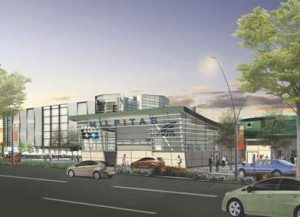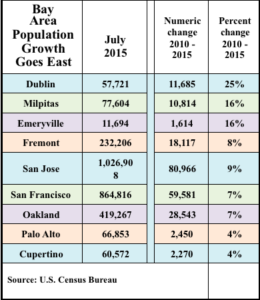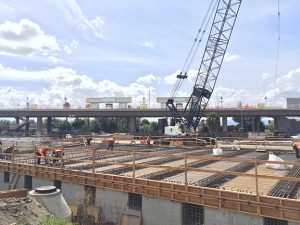Has the pendulum swung?
East Bay suburbs are leading national population growth even as traditionally prestigious Silicon Valley residential enclaves are struggling to keep residents.
By Sharon Simonson

Milpitas and Dublin each added more than 5 percent to their populations in the last year alone. Their East Bay neighbors Emeryville, Fremont and the far East Bay’s Brentwood are also growing fast. Fremont has added more than 18,000 people since 2010, reaching 232,000 residents in total.
But in what might be an ominous sign, a string of Silicon Valley’s most remote and expensive western suburbs are seeing their populations plateau and even begin to decline. According to just-released U.S. Census figures, more people left Palo Alto last year than moved in, and the same was true in Campbell, Los Gatos, Saratoga and even Cupertino, home to booming Apple Inc.

Palo Alto’s decline is tiny — a quarter of a percentage point from 2014 to 2015 — and only one year in duration. But it is striking in that the city has long been considered Silicon Valley’s technology epicenter ![]() and economic vanguard. It has the most expensive housing and commercial properties, and its recovery following the region’s dot-com and 2008 busts signaled the start of explosive growth region-wide. The city’s snobbish reputation stems at least in part from a well-known dislike of newcomers and development and a consistent thwarting of outsiders’ push to get in. Cupertino may be even less welcoming.
and economic vanguard. It has the most expensive housing and commercial properties, and its recovery following the region’s dot-com and 2008 busts signaled the start of explosive growth region-wide. The city’s snobbish reputation stems at least in part from a well-known dislike of newcomers and development and a consistent thwarting of outsiders’ push to get in. Cupertino may be even less welcoming.
City leaders in Milpitas and Dublin cite BART stations (to-come and existing) that connect them quickly to the rich vein of well-paying jobs from Silicon Valley to San Francisco as the precipitating factor for their population climb, not to mention available development property and relatively lower living costs.
Dublin’s population has expanded by a quarter since 2010, the Census Bureau says. Some residents are reeling from the changes and onslaught of dense traffic, while schools are overflowing, Mayor David Haubert says: “We have now seen three-story homes not unlike the Victorian row houses in the city with a smaller footprint and more per acre than condos or apartments.”

The current city council is in some ways powerless to stop the onslaught, the mayor says, as previous elected leaders signed long-term development agreements that still obligate the city today.
“We are a boom town right now,” Milpitas Vice Mayor Carmen Montano says. The bulk of the city’s new housing is high-density and adjacent to the new BART station, which won’t be finished until next year. The town’s population is up more than 16 percent in five years, climbing by more than 10,000 to nearly 78,000.
“Most of the people who are moving in are engineers and the ones who are making a lot of money. They come from all over the world — India, China — there is a huge Asian population coming,” she says.
Mountain View and Sunnyvale, which saw early and strong growth in the present economic expansion that was also attributed to their transit connections, continued strong, adding not quite 9 percent each to their populations in the last five years. Redwood City, with its rapidly rising transit-oriented downtown, grew 11 percent from 2010 to mid-2015.
San Francisco added more than 12,000 new residents from mid-2014 to mid-2015, the year the census estimates reflect. That was more than in San Jose and Oakland and among the top greatest numeric increases of all cities in the country. But measured over the last five years, San Jose’s growth has been fastest of the Bay Area’s principal cities and the self-described “Capital of Silicon Valley” attracted more than 81,000 new residents since 2010.
Most of the nation’s fastest growing cities are in Texas, the Census Bureau says.